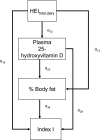Associations among 25-hydroxyvitamin D, diet quality, and metabolic disturbance differ by adiposity in adults in the United States
- PMID: 20463091
- PMCID: PMC2913037
- DOI: 10.1210/jc.2010-0410
Associations among 25-hydroxyvitamin D, diet quality, and metabolic disturbance differ by adiposity in adults in the United States
Abstract
Context: Recent evidence indicates that a higher plasma level of 25-hydroxyvitamin D [25(OH)D] is associated with lower adiposity and a reduced number of metabolic disturbances (MetD).
Objectives: We examined associations among dietary quality, 25(OH)D, percent body fat (%BF), and MetD, and a pathway linking them, across central obesity.
Design: This cross-sectional nationally representative study used extensive data from the National Health and Nutrition Examination Surveys of 2001-2004.
Participants: U.S. adults aged at least 20 yr were stratified by central obesity (CO) status. Sample sizes ranged from 1943 (all MetD combined) to 7796 (each component).
Main outcome measures: %BF was measured using dual-energy x-ray absorptiometry, and MetD was measured with individual continuous nonadiposity outcomes (e.g. fasting plasma glucose) and with a composite count index of binary MetD with prespecified cutoff points (Index I).
Results: A higher 25(OH)D was associated with better dietary quality, lower %BF, and lower number of MetD. These inverse 25(OH)D-%BF and 25(OH)D-MetD associations (i.e. fasting blood glucose, homeostatic model assessment of insulin resistance, C-reactive protein, and Index I) were significantly stronger among the CO+ group. Finally, the pathway linking the dairy component of the Healthy Eating Index (HEIdairy) to Index I through 25(OH)D and %BF indicated complete mediation among the CO- group, but HEIdairy and 25(OH)D had direct inverse associations with Index I among the CO+ group.
Conclusions: Due to potential genetic differences between CO- and CO+ groups, empowering U.S. adults with central obesity to make related behavioral changes may be especially effective in improving their vitamin D status and metabolic profile.
Figures



Similar articles
-
25-hydroxyvitamin D is associated with adiposity and cardiometabolic risk factors in a predominantly vitamin D-deficient and overweight/obese but otherwise healthy cohort.J Steroid Biochem Mol Biol. 2017 Oct;173:258-264. doi: 10.1016/j.jsbmb.2016.12.008. Epub 2016 Dec 19. J Steroid Biochem Mol Biol. 2017. PMID: 28007531
-
The Apparent Relation between Plasma 25-Hydroxyvitamin D and Insulin Resistance is Largely Attributable to Central Adiposity in Overweight and Obese Adults.J Nutr. 2015 Dec;145(12):2683-9. doi: 10.3945/jn.115.220541. Epub 2015 Oct 7. J Nutr. 2015. PMID: 26446485 Free PMC article. Clinical Trial.
-
Fat Distribution as a Determinant of Vitamin D Status: A Cross-Sectional Study of Adults in the United States.Int J Vitam Nutr Res. 2024 Dec 27;95(1):36625. doi: 10.31083/IJVNR36625. Int J Vitam Nutr Res. 2024. PMID: 40134250
-
Adiposity, vitamin D requirements, and clinical implications for obesity-related metabolic abnormalities.Nutr Rev. 2018 Sep 1;76(9):678-692. doi: 10.1093/nutrit/nuy034. Nutr Rev. 2018. PMID: 30020507 Review.
-
Protective effects of puerarin on metabolic diseases: Emphasis on the therapeutical effects and the underlying molecular mechanisms.Biomed Pharmacother. 2024 Oct;179:117319. doi: 10.1016/j.biopha.2024.117319. Epub 2024 Aug 27. Biomed Pharmacother. 2024. PMID: 39197190 Review.
Cited by
-
Effects of weight loss on serum vitamin D in postmenopausal women.Am J Clin Nutr. 2011 Jul;94(1):95-103. doi: 10.3945/ajcn.111.015552. Epub 2011 May 25. Am J Clin Nutr. 2011. PMID: 21613554 Free PMC article. Clinical Trial.
-
Vitamin D has therapeutic effects on obesity and hyperandrogenemia in PCOS mouse model induced by low dose DHEA and high-fat diet.BMC Womens Health. 2024 Nov 9;24(1):601. doi: 10.1186/s12905-024-03445-w. BMC Womens Health. 2024. PMID: 39521978 Free PMC article.
-
Serum 25-hydroxyvitamin D3 and body composition in an elderly cohort from Germany: a cross-sectional study.Nutr Metab (Lond). 2012 May 18;9(1):42. doi: 10.1186/1743-7075-9-42. Nutr Metab (Lond). 2012. PMID: 22607088 Free PMC article.
-
Serum vitamin D is low and inversely associated with LDL cholesterol in the Kazak ethnic population: a cross-sectional study.Med Sci Monit. 2014 Jul 23;20:1274-83. doi: 10.12659/MSM.890930. Med Sci Monit. 2014. PMID: 25064492 Free PMC article.
-
Association between intake of sugar-sweetened beverages and circulating 25-hydroxyvitamin D concentration among premenopausal women.Nutrients. 2014 Jul 28;6(8):2987-99. doi: 10.3390/nu6082987. Nutrients. 2014. PMID: 25072269 Free PMC article.
References
-
- Mølgaard C, Michaelsen KF 2003 Vitamin D and bone health in early life. Proc Nutr Soc 62:823–828 - PubMed
-
- Smith P, Barzel US 1984 Vitamin D deficiency osteomalacia in elderly persons. Compr Ther 10:24–32 - PubMed
-
- Rizzoli R, Eisman JA, Norquist J, Ljunggren O, Krishnarajah G, Lim SK, Chandler J 2006 Risk factors for vitamin D inadequacy among women with osteoporosis: an international epidemiological study. Int J Clin Pract 60:1013–1019 - PubMed
-
- Lips P 2007 Vitamin D status and nutrition in Europe and Asia. J Steroid Biochem Mol Biol 103:620–625 - PubMed
-
- Poole KE, Loveridge N, Barker PJ, Halsall DJ, Rose C, Reeve J, Warburton EA 2006 Reduced vitamin D in acute stroke. Stroke 37:243–245 - PubMed
Publication types
MeSH terms
Substances
Grants and funding
LinkOut - more resources
Full Text Sources
Medical
Research Materials
Miscellaneous

